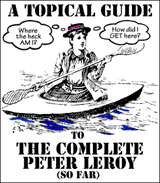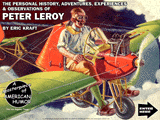
by Mark Dorset
from Very Large Fiction
By Mark Dorset
![]() ometimes
my author feels as if he has become a character in his own work.
Of course, he has. The Eric Kraft
who does his writing is someone he has made over the course of the thirty-something
years that he has been making the world in which I live. The writing
Kraft is the private, authorial version of himself. There is also
a public version of him, but I sometimes think, and he sometimes feels,
that the private person, the author, has become the only true self, the
only completely real Eric Kraft, and that all the rest of us—his fictional
characters and his public self—are the products of his labor.
ometimes
my author feels as if he has become a character in his own work.
Of course, he has. The Eric Kraft
who does his writing is someone he has made over the course of the thirty-something
years that he has been making the world in which I live. The writing
Kraft is the private, authorial version of himself. There is also
a public version of him, but I sometimes think, and he sometimes feels,
that the private person, the author, has become the only true self, the
only completely real Eric Kraft, and that all the rest of us—his fictional
characters and his public self—are the products of his labor.
Here is the critic Michael Wood on that subject, from
his appreciation of Vladimir Nabokov entitled The Magician's Doubts:
Nabokov and the Risks of Fiction:
“The poet,” Yeats said, “is never the bundle of accident and incoherence that sits down to breakfast.” Proust said the same more generally for the writer: “a book is the product of another self (un autre moi) than the one we display in our habits, in society, in our vices.”Actually, Wood chooses to omit a portion of Yeats’s remarks that he may have felt depreciated the value of the novelist in comparison with that of the poet, a few additional words that, given the fact that he was writing an appreciation of one of the very best of all novelists, he chose not to include; Yeats went on to say:
he [the poet] has been reborn as an idea, something intended, complete. A novelist might describe his accidence, his incoherence, he must not; he is more type than man, more passion than type. . . . He is part of his own phantasmagoria . . .Well, I can tell you from personal experience that my author certainly does choose to describe his accidence and incoherence, albeit in a deliberate and coherent manner, that he is no less intended or complete than any poet, and that he is most certainly no less a part of his own phantasmagoria. So there.
Of what one feels, who could have thought to make
So many selves . . .
Wallace Stevens
“Esthetique du Mal”
![]()

The area outside the outermost ring represents the ambient reality through which the author moves and from which he gets everything that he knows of everything there is; this is what Emerson called “the actual world—the painful kingdom of time and place—[where] dwell care, and canker, and fear.”Schematic diagram of an author, showing the progress of an event from outside the author (the bite of a whining mosquito, an ant, or a spider, for example) to a position within the author’s imagination (as a whining character, perhaps) and its subsequent return to the outside world (in a novel, to name one example).
The first ring is the author’s persona, a thin protective shell around the author within. Notice, however that the ring of persona is gray and fuzzy, as are all the areas in the diagram. These qualities in the schematic, grayness and fuzziness, are meant to indicate (1) permeability, the fact that information can pass through an area (in both directions) and (2) imprecision, the fact that the boundaries of the regions are ill-defined, not sharp and precise. So, the persona is a kind of semipermeable membrane, through which information about the real world can pass into the region of the author and through which the products of the author can pass into the real world.
The region within the edge of the outer shell is the totality of the person who contains an author, un autre. The region within the author’s ring is the region of the author—but remember that in the case of a region with fuzzy edges we have a difficult time saying where, exactly, the edge of the region is, where the region stops. Remember also, please, that Author Kraft is a creation of Total Kraft’s, or if you like, a character in a work of Total Kraft’s, as is Persona Kraft; now, if we consider that Total Kraft includes Author Kraft and Persona Kraft, then we must take the creation of the totality of Kraft to be a work of Total Kraft’s, too: a kind of fiction, as, of course, it is, but if we pursue that line we’ll go on pursuing it and pursing it without ever getting to the end of it, and we'll all get really splitting headaches, so let’s return to the characters who appear on printed pages, or more broadly considered, characters manifested through words, and confine ourselves to them.
To answer a question asked of all authors: yes, all of those characters (including, of course, me) have their origins in the region outside the author, in the real world.
I mean what I said and only what I said, that we all have our origins there, but I do not mean that we all have relatives out there, bundles of accident and incoherence who are wondering what’s for breakfast, and I do not even mean that we all necessarily originate from people out there. Some of us have arisen from other things: a melody that suggested a singer; moonlight that seemed to call for a pair of lovers; or even a vacancy toward which people seemed to turn, a vacancy that implied a missing someone. Now that I have qualified it, I will repeat it: all of us originated outside. Each of us began as a perception; that is, something from the region outside that was taken in to the region of the author. (I employ the passive voice here because so many perceptions are accidental, unwilled. For example, just a few days ago, while I was enjoying a rare hour of relaxation, lying in the sun on a chaise longue, reading Anthony Trollope's The Small House at Allington, I was, apparently, bitten by some insect of which I was at the time unaware, but which seems to have injected me with a toxin to which I have had an allergic reaction, leaving my right side and an area of my lower back just above my right buttock covered with red welts that are sore enough to make sleeping uncomfortable, giving rise, as you might expect, to uneasy dreams.)
So, we all began as perceptions, but all perceptions are misperceptions, because (a) our senses simplify and distort what we perceive, (b) an instant later, the intellect has further distorted and simplified the already simplified and distorted perception and categorized it and filed it for reference in the memory, so that it is now (c) only a recollection of a perception, a shadow of its former self, and by some mysterious process still poorly understood despite the best efforts of students of consciousness, these memories begin an apparently inevitable drift toward the region of the imagination, where they are massaged and amplified and bent and twisted until they are scarcely recognizable as the offspring of the bits of the outside world that gave rise to them. Thus, Scrooge’s undigested bit of mutton becomes the Ghost of Christmas Past, and thus there are no immediate experiences, and thus there are no characters drawn directly from life. We are, each of us, born, or made, somewhere along the path from the real world to the region of the imagination.
Our imagination, and our dreams, are forever invading our memories; and since we are all apt to believe in the reality of our fantasies, we end up transforming our lies into truths. Of course, fantasy and reality are equally personal, and equally felt, so their confusion is a matter of only relative importance. . . . I am the sum of my errors and doubts as well as my certainties.Luis Buñuel, My Last Sigh
(his autobiography, translated by Abigail Israel)
The Making of Peter Leroy
The Birth and Astonishing Development of Ariane Lodkochnikov
The Author As Clam: A Schematic Comparison

